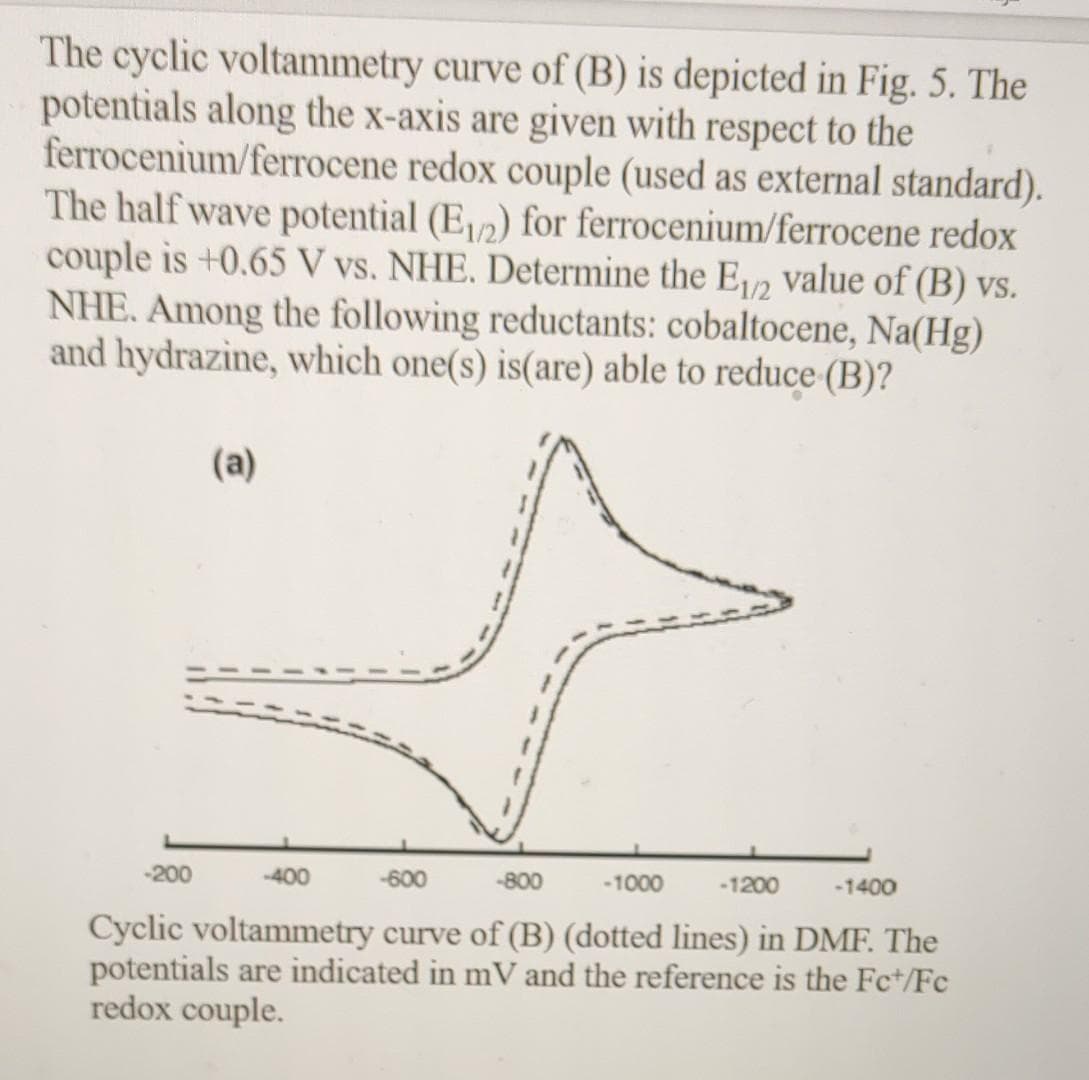The cyclic voltammetry curve of (B) is depicted in Fig. 5. The potentials along the x-axis are given with respect to the ferrocenium/ferrocene redox couple (used as external standard). The half wave potential (E2) for ferrocenium/ferrocene redox couple is +0.65 V vs. NHE. Determine the E2 value of (B) vs. NHE. Among the following reductants: cobaltocene, Na(Hg) and hydrazine, which one(s) is(are) able to reduce (B)?
The cyclic voltammetry curve of (B) is depicted in Fig. 5. The potentials along the x-axis are given with respect to the ferrocenium/ferrocene redox couple (used as external standard). The half wave potential (E2) for ferrocenium/ferrocene redox couple is +0.65 V vs. NHE. Determine the E2 value of (B) vs. NHE. Among the following reductants: cobaltocene, Na(Hg) and hydrazine, which one(s) is(are) able to reduce (B)?
Principles of Instrumental Analysis
7th Edition
ISBN:9781305577213
Author:Douglas A. Skoog, F. James Holler, Stanley R. Crouch
Publisher:Douglas A. Skoog, F. James Holler, Stanley R. Crouch
Chapter25: Voltammetry
Section: Chapter Questions
Problem 25.12QAP
Related questions
Question
please help me in this particular question

Transcribed Image Text:The cyclic voltammetry curve of (B) is depicted in Fig. 5. The
potentials along the x-axis are given with respect to the
ferrocenium/ferrocene redox couple (used as external standard).
The half wave potential (E12) for ferrocenium/ferrocene redox
couple is +0.65 V vs. NHE. Determine the E/2 value of (B) vs.
NHE. Among the following reductants: cobaltocene, Na(Hg)
and hydrazine, which one(s) is(are) able to reduce (B)?
(a)
-200
-400
-600
-800
-1000
-1200
-1400
Cyclic voltammetry curve of (B) (dotted lines) in DMF. The
potentials are indicated in mV and the reference is the Fc+/Fc
redox couple.
Expert Solution
This question has been solved!
Explore an expertly crafted, step-by-step solution for a thorough understanding of key concepts.
This is a popular solution!
Trending now
This is a popular solution!
Step by step
Solved in 2 steps with 2 images

Knowledge Booster
Learn more about
Need a deep-dive on the concept behind this application? Look no further. Learn more about this topic, chemistry and related others by exploring similar questions and additional content below.Recommended textbooks for you

Principles of Instrumental Analysis
Chemistry
ISBN:
9781305577213
Author:
Douglas A. Skoog, F. James Holler, Stanley R. Crouch
Publisher:
Cengage Learning

Principles of Modern Chemistry
Chemistry
ISBN:
9781305079113
Author:
David W. Oxtoby, H. Pat Gillis, Laurie J. Butler
Publisher:
Cengage Learning


Principles of Instrumental Analysis
Chemistry
ISBN:
9781305577213
Author:
Douglas A. Skoog, F. James Holler, Stanley R. Crouch
Publisher:
Cengage Learning

Principles of Modern Chemistry
Chemistry
ISBN:
9781305079113
Author:
David W. Oxtoby, H. Pat Gillis, Laurie J. Butler
Publisher:
Cengage Learning
